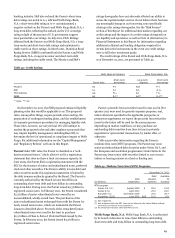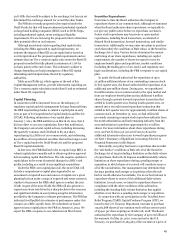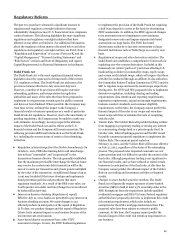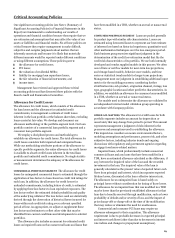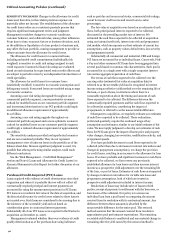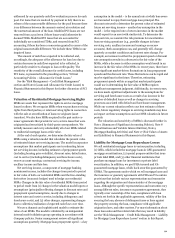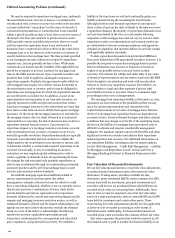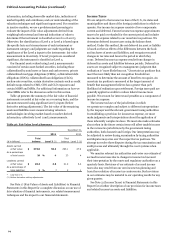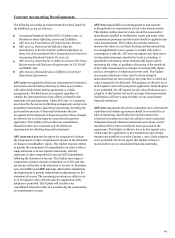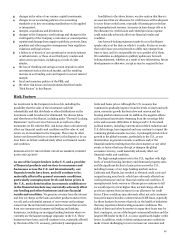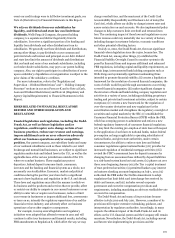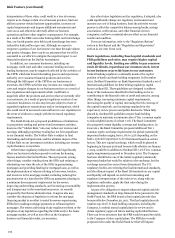Wells Fargo 2011 Annual Report Download - page 94
Download and view the complete annual report
Please find page 94 of the 2011 Wells Fargo annual report below. You can navigate through the pages in the report by either clicking on the pages listed below, or by using the keyword search tool below to find specific information within the annual report.Critical Accounting Policies (continued)
We may be required to repurchase mortgage loans, indemnify
the securitization trust, investor or insurer, or reimburse the
securitization trust, investor or insurer for credit losses incurred
on loans (collectively “repurchase”) in the event of a breach of
contractual representations or warranties that is not remedied
within a period (usually 90 days or less) after we receive notice of
the breach. Our loan sale contracts to private investors (non-
GSE) typically contain an additional provision where we would
only be required to repurchase loans if any such breach is
deemed to have a material and adverse effect on the value of the
mortgage loan or to the interests of the investors or interests of
security holders in the mortgage loan. The time periods specified
in our mortgage loan sales contracts to respond to repurchase
requests vary, but are generally 90 days or less. While many
contracts do not include specific remedies if the applicable time
period for a response is not met, contracts for mortgage loan
sales to the GSEs include various types of specific remedies and
penalties that could be applied to inadequate responses to
repurchase requests. Similarly, the agreements under which we
sell mortgage loans require us to deliver various documents to
the securitization trust or investor, and we may be obligated to
repurchase any mortgage loan for which the required documents
are not delivered or are defective. In addition, as part of our
representations and warranties in our loan sales contracts, we
typically represent to GSEs and private investors that certain
loans have mortgage insurance to the extent there are loans that
have loan to value ratios in excess of 80% that require mortgage
insurance. To the extent the mortgage insurance is rescinded by
the mortgage insurer due to a claim of breach of a contractual
representation or warranty, the lack of insurance may result in a
repurchase demand from an investor. Upon receipt of a
repurchase request or a mortgage insurance rescission, we work
with securitization trusts, investors or insurers to arrive at a
mutually agreeable resolution. Repurchase demands are typically
reviewed on an individual loan by loan basis to validate the
claims made by the securitization trust, investor or insurer, and
to determine whether a contractually required repurchase event
occurred. Occasionally, in lieu of conducting a loan level
evaluation, we may negotiate global settlements in order to
resolve a pipeline of demands in lieu of repurchasing the loans.
We manage the risk associated with potential repurchases or
other forms of settlement through our underwriting and quality
assurance practices and by servicing mortgage loans to meet
investor and secondary market standards.
We establish mortgage repurchase liabilities related to
various representations and warranties that reflect
management’s estimate of losses for loans for which we could
have a repurchase obligation, whether or not we currently service
those loans, based on a combination of factors. Such factors
include default expectations, expected investor repurchase
demands (influenced by current and expected mortgage loan file
requests and mortgage insurance rescission notices, as well as
estimated demand to default and file request relationships) and
appeals success rates (where the investor rescinds the demand
based on a cure of the defect or acknowledges that the loan
satisfies the investor’s applicable representations and
warranties), reimbursement by correspondent and other third
party originators, and projected loss severity. We establish a
liability at the time loans are sold and continually update our
liability estimate during the remaining life of such loans.
Although investors may demand repurchase at any time and
there is often a lag from the date of default to the time we receive
a repurchase demand, the majority of repurchase demands occur
on loans that default in the first 24 to 36 months following
origination of the mortgage loan and can vary by investor. Most
repurchases under our representation and warranty provisions
are attributable to borrower misrepresentations and appraisals
obtained at origination that investors believe do not fully comply
with applicable industry standards.
To date, repurchase demands from private label MBS have
been more limited than GSE-guaranteed securities; however, it is
possible that requests to repurchase mortgage loans in private
label securitizations may increase in frequency as investors
explore every possible avenue to recover losses on their
securities. We evaluate the validity and materiality of any claim
of breach of representations and warranties in private label MBS
that is brought to our attention and work with securitization
trustees to resolve any repurchase requests. Nevertheless, we
may be subject to legal and other expenses if private label
securitization trustees or investors choose to commence legal
proceedings in the event of disagreements.
The mortgage loan repurchase liability at December 31, 2011,
represents our best estimate of the probable loss that we may
incur for various representations and warranties in the
contractual provisions of our sales of mortgage loans. Because
the level of mortgage loan repurchase losses are dependent on
economic factors, investor demand strategies and other external
conditions that may change over the life of the underlying loans,
the level of the liability for mortgage loan repurchase losses is
difficult to estimate and requires considerable management
judgment. We maintain regular contact with the GSEs and other
significant investors to monitor and address their repurchase
demand practices and concerns. For additional information on
our repurchase liability, including an adverse impact analysis,
see the “Risk Management – Credit Risk Management – Liability
for Mortgage Loan Repurchase Losses” section and Note 9
(Mortgage Banking Activities) to Financial Statements in this
Report.
Fair Valuation of Financial Instruments
We use fair value measurements to record fair value adjustments
to certain financial instruments and to determine fair value
disclosures. Trading assets, securities available for sale,
derivatives, prime residential MHFS, certain commercial LHFS,
certain loans held for investment, principal investments and
securities sold but not yet purchased (short sale liabilities) are
recorded at fair value on a recurring basis. Additionally, from
time to time, we may be required to record at fair value other
assets on a nonrecurring basis, such as certain MHFS and LHFS,
loans held for investment and certain other assets. These
nonrecurring fair value adjustments typically involve application
of lower-of-cost-or-market accounting or write-downs of
individual assets. Additionally, for financial instruments not
recorded at fair value we disclose the estimate of their fair value.
Fair value represents the price that would be received to sell
the financial asset or paid to transfer the financial liability in an
92



